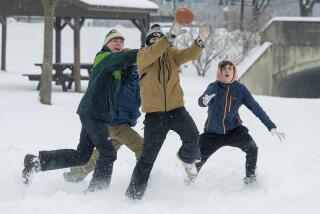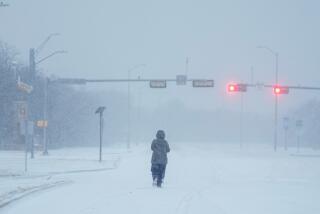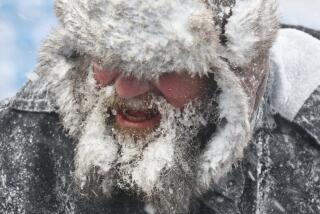Weather Rewrote Record Books
WASHINGTON — The suspicions of millions of shivering Americans were confirmed Friday by government weather experts: It was the nation’s coldest November-December period.
“Two months in a row of much below average temperatures resulted in the coldest November-December U.S. temperature on record, 33.8 degrees Fahrenheit,” said Jay Lawrimore, chief of the Climate Monitoring Branch at the National Climatic Data Center. The old record was 34.2 degrees, set in 1898.
It was the country’s second-coldest November nationwide and the seventh-coldest December, according to records kept by the Asheville, N.C., center.
And the outlook isn’t cheering.
National Weather Service Director Jack Kelly said the weather of 2000 was shaped by variability and extremes, which will continue throughout the winter.
“The Eastern and Western United States will experience additional cold outbreaks at least through March with periods of moderation in between,” he said.
The wintry weather was not unexpected, however, with the National Weather Service calling for a return to more normal winter conditions after several years of mild winters, Lawrimore noted.
The El Nino-La Nina weather phenomenon in the Pacific Ocean has faded into a near neutral state, eliminating that strong weather influence of the last few years.
Now conditions are more like those of the 1970s, he said, with the jet stream--the fast, high-level wind that helps direct the movement of weather--forming a trough in the central and Eastern U.S., bringing Arctic air southward over the country.
Forty-three states within the contiguous U.S., including California, recorded below average temperatures during the November-December period, according to records kept by the center, a division of the government’s National Oceanic and Atmospheric Administration.
The only states that had near normal temperatures were Nevada, New Mexico, New Hampshire, Vermont and Maine. The national averages do not include Alaska and Hawaii.
The report noted that severe conditions hit the Central and Southern Plains particularly hard. It was the coldest November-December on record in Oklahoma, Arkansas and Missouri, and the second-coldest such period for Illinois, Iowa, Kansas, Texas, Louisiana and Mississippi.
Heavy snow also accompanied the cold in many areas.
Temperatures dipped Friday to 16 degrees as Florida’s worst cold spell in 11 years slid into its third week and farmers looked at extensive damage to sugar cane, tomatoes and other crops.
U.S. Sugar Corp. said many of its 420,000 acres of sugar cane in Palm Beach and Hendry counties may be lost. “We’ll be looking at significant damage,” spokeswoman Judy Sanchez said.
The multimillion-dollar citrus industry has fared better, said Mike Carlton, with Florida Citrus Mutual. Some growers sprayed their citrus crops with water to freeze them to protect them from more damaging cold air.
This winter’s record cold was a sharp change from most of last year, which began with the warmest winter on record. Above normal temperatures continued through October and made the January-to-November period the warmest such 10-month period since national temperature records were first kept in 1895.
Preliminary data indicate that 2000 will be the 13th-warmest year on record in the U.S.--1.2 degrees above the long-term average of 52.8, the center reported.
More to Read
Sign up for Essential California
The most important California stories and recommendations in your inbox every morning.
You may occasionally receive promotional content from the Los Angeles Times.










